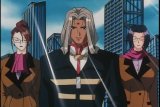

Quick Links:
Angel Links, Volume 1: Avenging Angel
While most of the Sunrise productions that have made it to the States so far have been mecha-oriented, following traditional themes…Sunrise does have an experimental side to it. In the past, they have funded some risky, genre-breaking shows such as Mister Ajiko, an anime series which is all about cooking. Angel Links really qualifies as one of these more experimental shows. It remains to be how successful an experiment it will turn out to be….
In spite of purportedly being set in the Outlaw Star universe, and covering an organization originally shown in Outlaw Star, Angel Links really is an entirely different show. Not just new characters and new starships, but new pacing, new themes, and new styles. The best way I can think of describing it is a strange hybrid between mahou shoujo and superheroic galactic anime. All the key elements of this hybrid get laid out on the table in the very first episode…
First of all, the show centers around a large, powerful starship, the Angel Links, which has a large, powerful cannon, the Links Cannon. Because this is superheroic galactic anime, enemies often conveniently line up to get blown away in a single blast of the Links Cannon. Similarly, all the other security ships which are a part of the Angel Links organization get easily pulverized early on in any engagement, so that every final showdown primarily relies on the Angel Links itself, and its crew.
But, that’s not all. The captain of the Angel Links happens to be a flamboyantly feminine and amply endowed sixteen year old girl – Li Meifon. Like all magical girls, she has a mascot called Taffei, and a bishounen love interest who appears in the beginning of the series, namely Leon Lau. Meifon’s mascot turns out to transform into a powerful sword that she can use to smite villains with superhuman ease…when she gets the determination to call on Taffei. Otherwise, she relies on her powerful martial arts training, nearby guns, and her reckless confidence to overcome any situation.
Sound just a mite bit stereotyped? That’s because it is. For all its experimental nature, Angel Links is chock-full of stereotypes, acting out in stereotypical ways. Meifon falls for the old decoy strategy every time. Villains reveal themselves and their motivations early on in every episode, and no episode is complete without a repeat of the lengthy Angel Links launch sequence. Cardboard-cutter nemeses and faceless minions get vaporized in scathes. Li Meifon fan service is in abundance.
But, despite the clash of the clichés which typifies the show, there are hints of possibly interesting things to come, if you look carefully. There are some ambiguous scenes that flash when Meifon does her first transformation sequence, and at the beginning of the next episode. While most of the stereotypes are treated with reverence, there are some truly humorous moments to be found, especially in the episode focusing on Duuz, which is my favorite of the bunch. The show highlights the shadier side of the commercial industry, where not all of the villains are pirates who can be shot down with the Links Cannon. And, when Meifon visits her grandfather’s grave, she passes by another gravestone with her own name marked on it – age 17. The only question is, will any of these themes be developed well enough in future volumes to merit stomaching the abundant trite and stewed elements?
Don’t expect the animation quality to decide the issue for you. CG is present at times, but not all that often, and it probably isn’t going to knock your socks off. The regular animation is about par for tv shows of either of the aforementioned anime genres – the melee combat is low on details, low on framerate, and low on originality. The lengthy animation sequence for the launch of the Angel Links will impress you more by its length than by its cool effects or interesting animation. The video transfer itself is not the highest quality – there is a good deal of pixellation on diagonal lines, and graininess crops up time and time again in the sky backgrounds. The one nice thing about the transfer is that at least care was taken to preserve the CG sequences – you do get to see the CG animation for the ether warping, for instance, without artifacts.
The audio tracks are standard Dolby Digital stereo sound, with a consistent and reasonable balance between the voices and background music. The soundtrack itself is so-so: the music generally does fit the moment, but not like a velvet glove. The main theme for the appearance and launch of the Angel Links was a bit overdone for my tastes, though, and neither of the vocal pieces are particularly stellar.
The packaging for the first volume seems to capitalize on the mahou shoujo themes of the film, featuring a stylized picture of Meifon as an angel, replete with her mascot. The disc art isn’t all that impressive – just a line drawing of Meifon in white on a blue background, with red for some of the text. The insert extra is fairly standard – a character description of Li Meifon on the back of the chapter stop list. On the disc itself, though, in addition to a textless opening, you get to see a clip from the episode where the Angel Links organization was originally introduced in Outlaw Star. This recap clip was well-chosen – a lot of people will probably buy this just based on the Outlaw Star connection, and appreciate quick access to the original clip, even if they don’t appreciate the show itself.
In closing, this disc isn’t for everyone. It isn’t even for most Outlaw Star fans. I would only recommend taking a look at this one if you’re a real fan of one of the two genres being crossed in Angel Links – mahou shoujo, or superheroic galactic anime. There just isn’t enough new content in place yet, and all too much hard-to-stomach premises present, to merit any interest for a more general audience.
Distributor: Bandai Creator: Sunrise Released: 1999
Video Quality: B- Audio Quality: B Presentation: B+ Content: C+ Overall: C+



